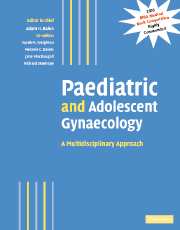Book contents
- Frontmatter
- Contents
- Contributors
- Preface
- Part I Normal development
- Part II Management of developmental abnormalities of the genital tract
- Part III Management of specific disorders
- 18 Disorders of growth and puberty
- 19 Turner's syndrome
- 20 Androgen insensitivity syndromes
- 21 Rokitansky syndrome and other Müllerian anomalies
- 22 The XY female
- 23 The gynaecology of the major genitourinary anomalies
- 24 Congenital adrenal hyperplasia
- 25 Long-term sequelae of genital surgery
- 26 Amenorrhoea
- 27 The polycystic ovary syndrome and adolescent women
- 28 Menstrual disorders in adolescent girls
- 29 Pelvic pain, ovarian cysts and endometriosis in adolescent girls
- 30 Premature ovarian failure and ovarian ageing
- 31 Gynaecological cancers in childhood
- 32 Late reproductive sequelae of treatment for childhood cancer
- 33 Preservation of fertility before cancer therapy
- 34 The management of infertility with surrogacy and egg donation
- 35 Dermatological conditions of the female genitalia
- 36 Vaginal discharge
- 37 Psychological gender development in individuals born with ambiguous genitalia
- 38 Eating disorders in adolescence
- 39 Nutritional amenorrhoea: long-term sequelae
- 40 How to set up a service: how to teach and train
- Index
- Plate section
- References
28 - Menstrual disorders in adolescent girls
from Part III - Management of specific disorders
Published online by Cambridge University Press: 04 May 2010
- Frontmatter
- Contents
- Contributors
- Preface
- Part I Normal development
- Part II Management of developmental abnormalities of the genital tract
- Part III Management of specific disorders
- 18 Disorders of growth and puberty
- 19 Turner's syndrome
- 20 Androgen insensitivity syndromes
- 21 Rokitansky syndrome and other Müllerian anomalies
- 22 The XY female
- 23 The gynaecology of the major genitourinary anomalies
- 24 Congenital adrenal hyperplasia
- 25 Long-term sequelae of genital surgery
- 26 Amenorrhoea
- 27 The polycystic ovary syndrome and adolescent women
- 28 Menstrual disorders in adolescent girls
- 29 Pelvic pain, ovarian cysts and endometriosis in adolescent girls
- 30 Premature ovarian failure and ovarian ageing
- 31 Gynaecological cancers in childhood
- 32 Late reproductive sequelae of treatment for childhood cancer
- 33 Preservation of fertility before cancer therapy
- 34 The management of infertility with surrogacy and egg donation
- 35 Dermatological conditions of the female genitalia
- 36 Vaginal discharge
- 37 Psychological gender development in individuals born with ambiguous genitalia
- 38 Eating disorders in adolescence
- 39 Nutritional amenorrhoea: long-term sequelae
- 40 How to set up a service: how to teach and train
- Index
- Plate section
- References
Summary
Introduction
In adolescence, anovulatory or oligo-ovulatory cycles are a common occurrence during the reproductive development process, and physiological hyperandrogenaemia is characteristic of this period of reproductive life. Oligo-anovulatory cycles may result in regular menstrual function when adulthood is reached or may be the first sign of an ongoing reproductive derangement. Anovulatory cycles in adolescence have a hyperandrogenic profile that correlates with increased mean luteinizing hormone (LH) levels, pulse amplitude and pulse frequency; there is also increased ovarian volume with a multicystic appearance. Although these endocrine findings probably represent a physiological condition in the first years after menarche, they may continue to the development of persistent reproductive disturbances. Individuals who ovulate and have regular cycles beginning at menarche, as well as those oligo-anovulatory adolescents who quickly normalize their cycles, have a more favourable reproductive prognosis.
The clinical implications of these common endocrine variations were examined in a longitudinal study of 34 girls from puberty to postmenarche and of 73 girls for one to seven years after menarche (Venturoli et al., 1986a, b, 1995).
Hormonal profiles of adolescents with irregular cycles
Of adolescents who have irregular cycles beginning at menarche but do not demonstrate other pathological features of androgen excess (such as obesity, acne, hirsutism, or major emotional/psychiatric disorders), 30% will demonstrate levels of androstenedione and testosterone above the upper limit of normal (Venturoli et al., 1986a) (Fig. 28.1). Subjects with increased androgen levels are generally anovulatory, although the occasional ovulatory girl may demonstrate hyperandrogenaemia.
- Type
- Chapter
- Information
- Paediatric and Adolescent GynaecologyA Multidisciplinary Approach, pp. 354 - 358Publisher: Cambridge University PressPrint publication year: 2004



